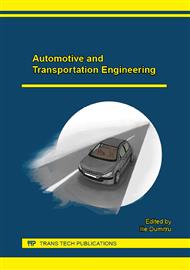p.224
p.230
p.235
p.243
p.252
p.261
p.272
p.285
p.293
Modeling and Diagnosis of a Powertrain through Specific Parameters
Abstract:
The paper presents a control algorithm for an internal combustion engine for a conventional vehicle in order to improve the comfort and driveability. Quick engine torque variations and direct interaction with the road produce driveline resonance frequency and oscillations, especially when the vehicle is used at full load. The processes from the combustion chamber engage different elements, involved in chemical reaction between air and fuel. The Matlab/Simulink software allows to optimize a few parameters involved in engine performances evolution. The injection time, the moment of injection, the load and the speed of the engine and whole electronic engine management guarantee a smooth regime of the engine and of the vehicle and reduce the noise and the pollutants and avoid supplementary stresses and dangereous oscillations of the drivetrain components of a vehicle.
Info:
Periodical:
Pages:
252-258
Citation:
Online since:
January 2016
Authors:
Keywords:
Price:
Сopyright:
© 2016 Trans Tech Publications Ltd. All Rights Reserved
Share:
Citation:


